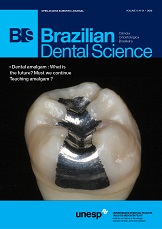Dental caries on distal surface of mandibular second molars
DOI:
https://doi.org/10.14295/bds.2015.v18i1.1063Resumo
Objective: The aim of the study was to evaluate the frequency of distal caries in the second molar influenced by the angulation of the third molar adjacent on panoramic radiographs in a clinical dental radiology. Material and Methods: A descriptive and quantitative study that examined 750 panoramic radiographs, of this total, 120 were in accordance with the inclusion criteria of the study was conducted. Results: 157 seconds and third molars analyzed the prevalence of caries in the distal of the second molar was 25.5%. The most prevalent angle position of the third molar was 57.3% with the vertical, but the position with the highest percentage of decayed molar second distal mesioangular was 50% of the cases. The elements listed, males obtained 40% of second molar distal caries versus 17% for females. People aged 35 or older had the highest incidence with 50% distal caries while other bands obtained 16.21% in the group 18-24 years, and 23.52% in 25-34 years. Conclusion: It was possible to establish a sliding scale on the indication for prophylactic removal of mandibular third molar according to the angulation of Winter: horizontal, mesioangular, vertical and distoangular. One can also see a greater relevance to the indication of prophylactic removal of male individuals aged over 35 years.
Downloads
Downloads
Arquivos adicionais
Publicado
Como Citar
Edição
Seção
Licença
TRANSFERÊNCIA DE DIREITOS AUTORAIS E DECLARAÇÃO DE RESPONSABILIDADE
Toda a propriedade de direitos autorais do artigo "____________________________________________________________________" é transferido do autor(es) para a CIÊNCIA ODONTOLÓGICA BRASILEIRA, no caso do trabalho ser publicado. O artigo não foi publicado em outro lugar e não foi submetido simultaneamente para publicação em outra revista.
Vimos por meio deste, atestar que trabalho é original e não apresenta dados manipulados, fraude ou plágio. Fizemos contribuição científica significativa para o estudo e estamos cientes dos dados apresentados e de acordo com a versão final do artigo. Assumimos total responsabilidade pelos aspectos éticos do estudo.
Este texto deve ser impresso e assinado por todos os autores. A versão digitalizada deverá ser apresentada como arquivo suplementar durante o processo de submissão.




























